All the solutions provided in McGraw Hill Math Grade 2 Answer Key PDF Chapter 4 Lesson 5 Subtract Two-Digit Numbers will give you a clear idea of the concepts.
McGraw-Hill My Math Grade 2 Answer Key Chapter 4 Lesson 5 Subtract Two-Digit Numbers
Explore and Explain
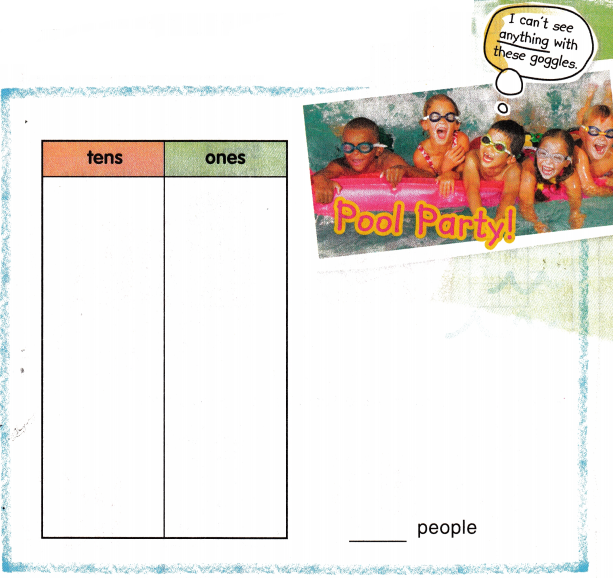
Teacher Directions: There are 42 people swimming at the pool. Use base-ten blocks to show those people. 13 people go home. Take away 13 base-ten blocks. Regroup if needed. Draw the base-ten blocks that are left in the chart. Write how many people are left. How many are left at the pool?
Explanation:
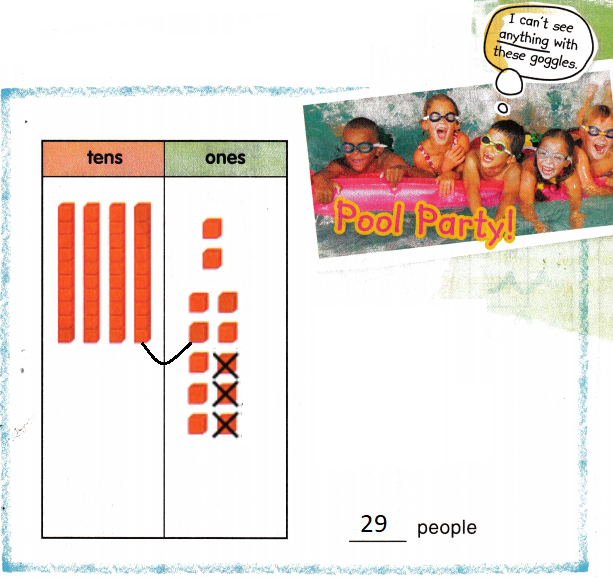
See and Show
Helpful Hint
Cross out numbers as you regroup them.
Find 52 – 17.
Step 1
Show 52.
Can you subtract 7 ones?
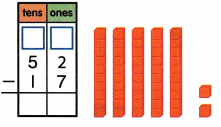
Step 2
Regroup 1 ten as 10 ones.
2 ones + 10 ones = 12 ones.
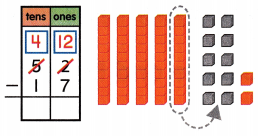
Step 3
Subtract the ones.
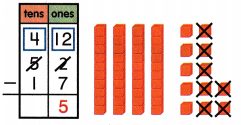
Step 4
Then subtract the tens.
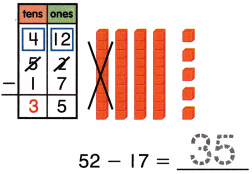
Use Work Mat 6 and base-ten blocks to subtract.
Question 1.
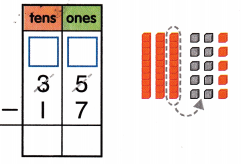
Answer:
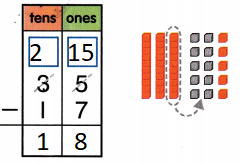
Explanation:
We cannot subtract a bigger number from a smaller number,
So, we have to regroup ones place as tens then we have to subtract.
One ten is regrouped as ten ones.
Question 2.
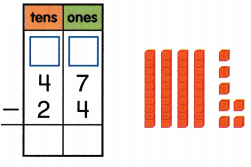
Answer:
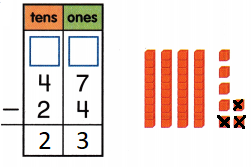
Explanation:
We cannot subtract a bigger number from a smaller number,
So, we have to regroup ones place as tens then we have to subtract.
One ten is regrouped as ten ones.
Talk Math How is subtracting 41 – 16 different than 41 – 6?
Answer:
41 – 16 = 25

41 – 6 = 35

Explanation:
We cannot subtract a bigger number from a smaller number,
So, we have to regroup ones place as tens then we have to subtract.
One ten is regrouped as ten ones.
On My Own
Use Work Mat 6 and base-ten blocks to subtract.
Question 3.
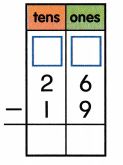
Answer:
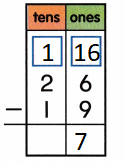
Explanation:
We cannot subtract a bigger number from a smaller number,
So, we have to regroup ones place as tens then we have to subtract.
One ten is regrouped as ten ones.
Question 4.
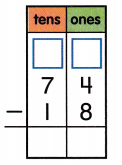
Answer:
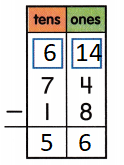
Explanation:
We cannot subtract a bigger number from a smaller number,
So, we have to regroup ones place as tens then we have to subtract.
One ten is regrouped as ten ones.
Question 5.
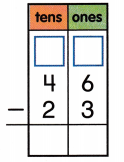
Answer:
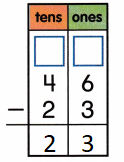
Explanation:
We cannot subtract a bigger number from a smaller number,
So, we have to regroup ones place as tens then we have to subtract.
One ten is regrouped as ten ones.
Question 6.
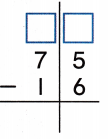
Answer:
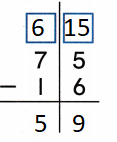
Explanation:
We cannot subtract a bigger number from a smaller number,
So, we have to regroup ones place as tens then we have to subtract.
One ten is regrouped as ten ones.
Question 7.
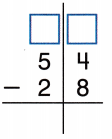
Answer:
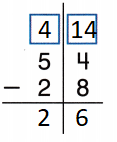
Explanation:
We cannot subtract a bigger number from a smaller number,
So, we have to regroup ones place as tens then we have to subtract.
One ten is regrouped as ten ones.
Question 8.
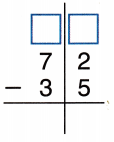
Answer:
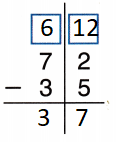
Explanation:
We cannot subtract a bigger number from a smaller number,
So, we have to regroup ones place as tens then we have to subtract.
One ten is regrouped as ten ones.
Question 9.
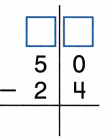
Answer:
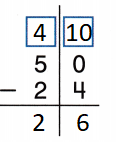
Explanation:
We cannot subtract a bigger number from a smaller number,
So, we have to regroup ones place as tens then we have to subtract.
One ten is regrouped as ten ones.
Question 10.
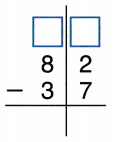
Answer:
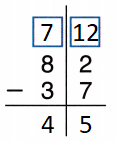
Explanation:
We cannot subtract a bigger number from a smaller number,
So, we have to regroup ones place as tens then we have to subtract.
One ten is regrouped as ten ones.
Question 11.
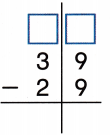
Answer:
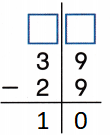
Explanation:
We cannot subtract a bigger number from a smaller number,
So, we have to regroup ones place as tens then we have to subtract.
One ten is regrouped as ten ones.
Question 12.

Answer:
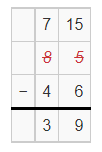
Explanation:
We cannot subtract a bigger number from a smaller number,
So, we have to regroup ones place as tens then we have to subtract.
One ten is regrouped as ten ones.
Question 13.

Answer:
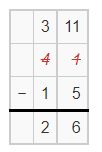
Explanation:
We cannot subtract a bigger number from a smaller number,
So, we have to regroup ones place as tens then we have to subtract.
One ten is regrouped as ten ones.
Question 14.

Answer:

Explanation:
We cannot subtract a bigger number from a smaller number,
So, we have to regroup ones place as tens then we have to subtract.
One ten is regrouped as ten ones.
Problem Solving
Question 15.
35 people are in line for the diving board at the pool. 16 people jump off the diving board. How many people are still in line?
____ people
Answer:
19 people
Explanation:
35 people are in line for the diving board at the pool.
16 people jump off the diving board.
35 – 16 = 19
19 people are still in line
Question 16.
Jason bought a pool pass for 45 trips to the pool. He has gone to the pool 28 times. How many more times can Jason go to the pool with his pass?
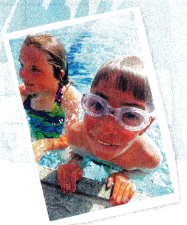
Answer:
17 times.
Explanation:
Jason bought a pool pass for 45 trips to the pool.
He has gone to the pool 28 times.
45 – 28 = 17
17 more times that Jason go to the pool with his pass
HOT Problem Ella, May, and Sue each pour 24 cups of lemonade for their lemonade stand. They sell 23 of the cups of lemonade to their friends. Row many cups are left to sell? Explain.
_________________________
_________________________
_________________________
_________________________
Answer:
49 cups.
Explanation:
Ella, May, and Sue each pour 24 cups of lemonade
24 + 24 + 24 = 72
23 of the cups of lemonade to their friends.
72 – 23 = 49
49 cups are left to sell
McGraw Hill My Math Grade 2 Chapter 4 Lesson 5 My Homework Answer Key
Practice
Subtract.
Question 1.
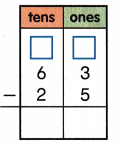
Answer:
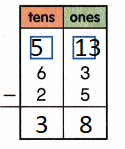
Explanation:
We cannot subtract a bigger number from a smaller number,
So, we have to regroup ones place as tens then we have to subtract.
One ten is regrouped as ten ones.
Question 2.
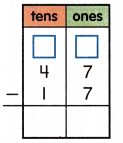
Answer:
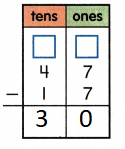
Explanation:
We cannot subtract a bigger number from a smaller number,
So, we have to regroup ones place as tens then we have to subtract.
One ten is regrouped as ten ones.
Question 3.
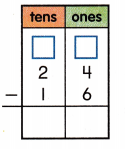
Answer:
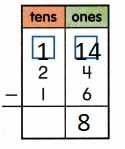
Explanation:
We cannot subtract a bigger number from a smaller number,
So, we have to regroup ones place as tens then we have to subtract.
One ten is regrouped as ten ones.
Question 4.
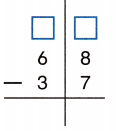
Answer:
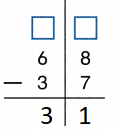
Explanation:
We cannot subtract a bigger number from a smaller number,
So, we have to regroup ones place as tens then we have to subtract.
One ten is regrouped as ten ones.
Question 5.
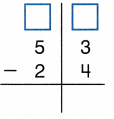
Answer:
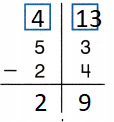
Explanation:
We cannot subtract a bigger number from a smaller number,
So, we have to regroup ones place as tens then we have to subtract.
One ten is regrouped as ten ones.
Question 6.
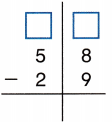
Answer:
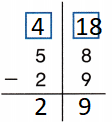
Explanation:
We cannot subtract a bigger number from a smaller number,
So, we have to regroup ones place as tens then we have to subtract.
One ten is regrouped as ten ones.
Subtract.
Question 7.

Answer:

Explanation:
We cannot subtract a bigger number from a smaller number,
So, we have to regroup ones place as tens then we have to subtract.
One ten is regrouped as ten ones.
Question 8.

Answer:
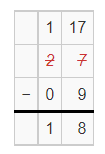
Explanation:
We cannot subtract a bigger number from a smaller number,
So, we have to regroup ones place as tens then we have to subtract.
One ten is regrouped as ten ones.
Question 9.

Answer:

Explanation:
We cannot subtract a bigger number from a smaller number,
So, we have to regroup ones place as tens then we have to subtract.
One ten is regrouped as ten ones.
Question 10.

Answer:

Explanation:
We cannot subtract a bigger number from a smaller number,
So, we have to regroup ones place as tens then we have to subtract.
One ten is regrouped as ten ones.
Question 11.

Answer:
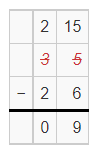
Explanation:
We cannot subtract a bigger number from a smaller number,
So, we have to regroup ones place as tens then we have to subtract.
One ten is regrouped as ten ones.
Question 12.

Answer:

Explanation:
We cannot subtract a bigger number from a smaller number,
So, we have to regroup ones place as tens then we have to subtract.
One ten is regrouped as ten ones.
Question 13.
83 people were at the water park. 29 people left. How many people were left at the water park?
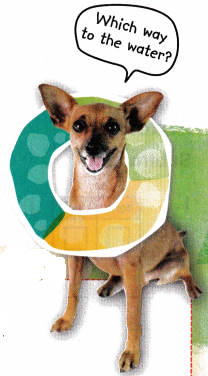
Answer:
Explanation:
83 people were at the water park.
29 people left.
83 – 29 = 54
54 people were left at the water park.
Test Practice
Question 14.
25 people brought dogs to the picnic. 18 of them were large dogs. How many small dogs were at the picnic?
(A) 6
(B) 7
(C) 13
(D) 17
Answer:
B
Explanation:
25 people brought dogs to the picnic.
18 of them were large dogs.
25 – 18 = 7
7 small dogs were at the picnic
Math at Home Ask your child to show you how to subtract 24 from 41.
Explanation:

Explanation:
We cannot subtract a bigger number from a smaller number,
So, we have to regroup ones place as tens then we have to subtract.
One ten is regrouped as ten ones.